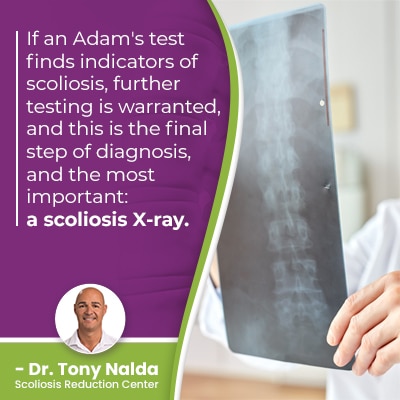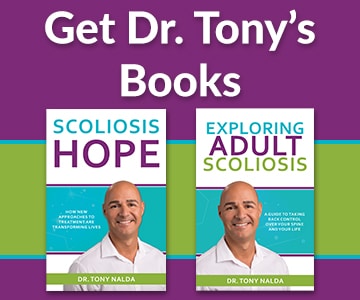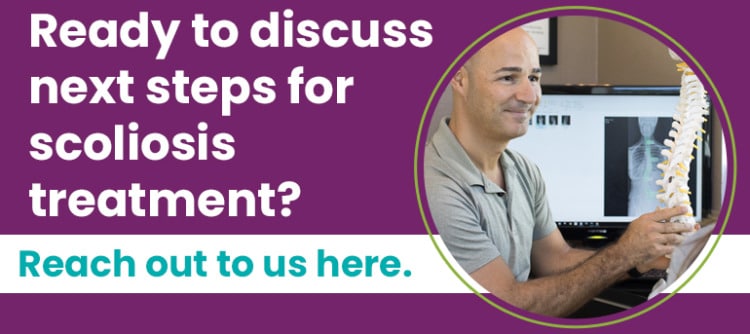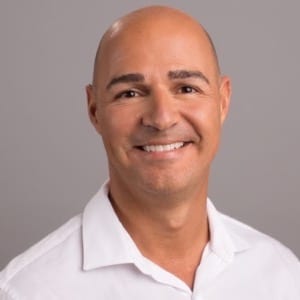When Is It Time to Refer for Scoliosis Care? [Find Out Here]
![When Is It Time to Refer for Scoliosis Care [Find Out Here]](https://drtonynalda.com/wp-content/uploads/2025/04/When-Is-It-Time-to-Refer-for-Scoliosis-Care_-Find-Out-Here.jpg)
While a general practitioner can diagnose scoliosis, the complexities of the condition necessitate the customization of treatment plans by a specialist. A family doctor can treat someone with scoliosis, but this is more about addressing the condition's symptoms than their underlying cause: the condition itself.
When it's time to seek assessment for scoliosis is when there are risk factors in place and/or there are warning signs present. When it's time to seek treatment for scoliosis and referral to a specialist is immediately following a diagnosis.
Let's explore a common path of scoliosis treatment, from first noticing the condition's signs to getting diagnosed and starting treatment.
Table of Contents
Signs of Scoliosis
Scoliosis is a spinal condition that causes an unnatural spinal curve to develop; the spine doesn't just bend unnaturally to the side, it also twists, making scoliosis a complex 3-dimensional condition.
Not only are there different types of scoliosis a person can develop, conditions range widely in severity from mild scoliosis to moderate scoliosis, severe and very severe scoliosis.
The signs of scoliosis developing differ largely based on a number of factors, one of which is patient age.
Signs of Childhood Scoliosis
Scoliosis introduces a lot of uneven forces to the spine, its surroundings, and the entire body, and those forces disrupt the body's overall symmetry.
In children, the main symptoms of scoliosis involve postural changes, with the earliest telltale signs often being uneven shoulders and uneven hips.
In children, the signs of scoliosis can change quickly because as a progressive condition that's triggered by growth, they can progress quickly.
Additional postural changes to watch for include uneven shoulder blades, the development of a rib cage arch, and arms and legs hanging at different lengths.
Disruptions to balance, coordination, and gait are also common.
The main sign of adult scoliosis is pain, and this is because scoliosis becomes compressive once skeletal maturity is reached, and scoliosis pain can involve the muscles, the back, and radiating pain into the extremities due to nerve compression.
As children are more frequently diagnosed and adolescent idiopathic scoliosis is the condition's most prevalent type, let's focus on an adolescent's journey from discovery to diagnosis and treatment.
What Happens When Signs of Scoliosis are Noticed?
So for adolescents, pain isn't a common part of the scoliosis experience, and this is a barrier to early detection.
In young patients with growth remaining, the spine is experiencing a constant lengthening motion that counteracts the compressive force of the unnatural spinal curve.
While adolescents can feel varying degrees of muscle pain, it's most often the postural changes that lead to assessment and diagnosis.
Some schools in the United States still have a school nurse conducting scoliosis screening, and if a routine school screening exam finds condition indicators in an adolescent, parents are notified that further evaluation of the child's spine by their doctor is necessary.
Another common scenario is that parents notice a child's postural changes while on vacation and seeing their child in a bathing suit; in many cases, adolescents will try to conceal changes they notice under baggy clothes and/or can compensate for changes in movement.
Many adolescents don't want to stand out or walk differently from their peers, so if they notice changes, they aren't always immediately shared.
So whether a school screening exam, a parent, or an adolescent notices some concerning postural changes, the next step is assessment by a professional, which is most often a child's family doctor.
Assessment and Diagnosis
Scoliosis screening means looking for signs of scoliosis that warrant further evaluation.
In addition, when certain risk factors are in place such as gender, age, and a family history, screening for scoliosis should be included as part of a child's routine check ups.
Females are more likely to be diagnosed earlier and are more likely to require treatment for continued progression, and this is due to the earlier start of puberty in females.
As growth triggers progression, there are benefits to diagnosing and treating scoliosis prior to the first significant pubescent growth spurt.
If another family member has been diagnosed, this is considered a risk factor because although scoliosis isn't considered genetic, it is considered familial.
So a child's family doctor will take a patient's medical history and family history and will conduct a physical examination that includes an Adams forward bend test.
A forward bend test is the main screening exam that involves examining a patient's spine and trunk while in a forward bend position.
In this position, the spine is highly visible, as are any related trunk asymmetries, and when combined with the use of a scoliometer, a patient's angle of trunk rotation (ATR) can also be determined.
 If an Adam's test finds indicators of scoliosis, further testing is warranted, and this is the final step of diagnosis, and the most important: a scoliosis X-ray.
If an Adam's test finds indicators of scoliosis, further testing is warranted, and this is the final step of diagnosis, and the most important: a scoliosis X-ray.
Scoliosis X-Ray Results
If a general practitioner has requisitioned a scoliosis X-ray, this is done because signs and/or risk factors of scoliosis are present.
A scoliosis X-ray is needed to reach a diagnosis of scoliosis; it's needed to confirm the spine's rotation and determine a patient's Cobb angle.
A minimum Cobb angle of 10 degrees is needed to be considered a true scoliosis.
A patient's Cobb angle is a key factor that treatment plans are shaped around, and it's a measurement that determines condition severity.
Scoliosis is classified as mild, moderate, severe, or very severe scoliosis based on the Cobb angle measurement that's determined during X-ray.
So if the results of a scoliosis X-ray confirm scoliosis is present, the patient's family doctor can inform the patient of their diagnosis, and this is where the path of treatment forks significantly: representing two different approaches to addressing scoliosis with treatment.
Traditional scoliosis treatment would then refer the adolescent to an orthopedic surgeon for treatment, and conservative scoliosis treatment would include referral to a scoliosis-specific chiropractor for non-surgical intervention.
Traditional Spinal Fusion Surgery
Traditional scoliosis treatment doesn't have a strategy for addressing scoliosis while mild so this path of treatment commonly involves a recommendation to watch and wait: meaning returning for periodic assessment to determine if progression is occurring.
But as a progressive condition, virtually all cases are going to progress, so watching and waiting can also mean wasting valuable treatment time while curves get larger and more complex to treat.
In between assessments, however, a growth spurt can occur that triggers significant progression, and had traditional treatment had an approach for addressing scoliosis while mild and started treatment earlier, progression to the severe level may have been avoidable.
In traditional treatment, little is done to prevent progression, and severe cases are commonly recommended for spinal fusion surgery.
Spinal fusion is an invasive procedure that fuses the curve's most-tilted vertebrae into one solid bone and attaches metal rods to the spine to hold it in place.
Spinal fusion can mean a spine that's straighter, but it can also mean a spine that's weaker and more vulnerable to injury, is less flexible with a reduced range of motion, and is more painful.
A fused spine is contrary to the spine's natural movement-based design, and the reality is that many cases of scoliosis don't require surgical treatment, particularly with early detection and intervention.
Modern Conservative Non-Surgical Scoliosis Treatment
Here at the Scoliosis Reduction Center®, immediately following a diagnosis is when we start treatment.
A goal of conservative treatment is to help patients avoid progression, increasing condition effects, and the need for future surgical treatment.
So for those wanting to forgo a surgical recommendation, or who simply want to try a less-invasive treatment option first, the results of this approach speaks for itself.
Integration is key as multiple scoliosis-specific treatment disciplines are combined so treatment plans can be fully customized and adjusted based on how the spine is responding to growth and/or treatment.
 Non-surgical scoliosis treatment combines the power of chiropractic care, physical therapy, scoliosis exercises, corrective bracing, and rehabilitation treatment.
Non-surgical scoliosis treatment combines the power of chiropractic care, physical therapy, scoliosis exercises, corrective bracing, and rehabilitation treatment.
While there are never treatment guarantees, for patients on the path of conservative treatment, successfully addressing scoliosis means minimizing its symptoms through preventing progression and restoring the spine's natural alignment, balance, and stability.
Conclusion
So when to refer for scoliosis is immediately following condition indicators being noticed.
Regular screening for scoliosis is also recommended if risk factors are in place such as gender, age, and a family history.
While a general practitioner can diagnose scoliosis and treat a patient with scoliosis, this is not the same as treating the scoliosis itself; a family doctor can prescribe certain stretches, exercises, and pain medications for symptoms relief, this isn't impacting the condition on a structural level for true corrective results.
Correcting scoliosis means reducing the size of the unnatural spinal curve on a structural level, increasing a patient's core and back-muscle strength for more support and stability for the spine, applying corrective bracing to help push the spine into a corrective position, and further rehabilitating the spine through home exercises and lifestyle guidance.
Scoliosis treatment is about addressing an ongoing condition, and with the scoliosis research society estimating close to seven million people living with scoliosis in the United States alone, awareness of the condition's early signs is important; it can lead to early detection.
While there are never treatment guarantees, there is a direct link between early diagnosis, proactive treatment, and treatment success.
The sooner scoliosis is diagnosed, the better because the sooner treatment is started, the better.
Dr. Tony Nalda
DOCTOR OF CHIROPRACTIC
After receiving an undergraduate degree in psychology and his Doctorate of Chiropractic from Life University, Dr. Nalda settled in Celebration, Florida and proceeded to build one of Central Florida’s most successful chiropractic clinics.
His experience with patients suffering from scoliosis, and the confusion and frustration they faced, led him to seek a specialty in scoliosis care. In 2006 he completed his Intensive Care Certification from CLEAR Institute, a leading scoliosis educational and certification center.
About Dr. Tony Nalda
 Ready to explore scoliosis treatment? Contact Us Now
Ready to explore scoliosis treatment? Contact Us Now





